

What’s inside this article: An in-depth guide designed to help teachers understand, recognize, and support sensory processing differences through the development of a sensory-friendly classroom using environmental modifications, sensory tools and equipment, and social-emotional education. This guide will help teachers make a sensory-friendly classroom where all students feel safe, comfortable, and ready to learn.
Disclaimer: This article contains affiliate links.
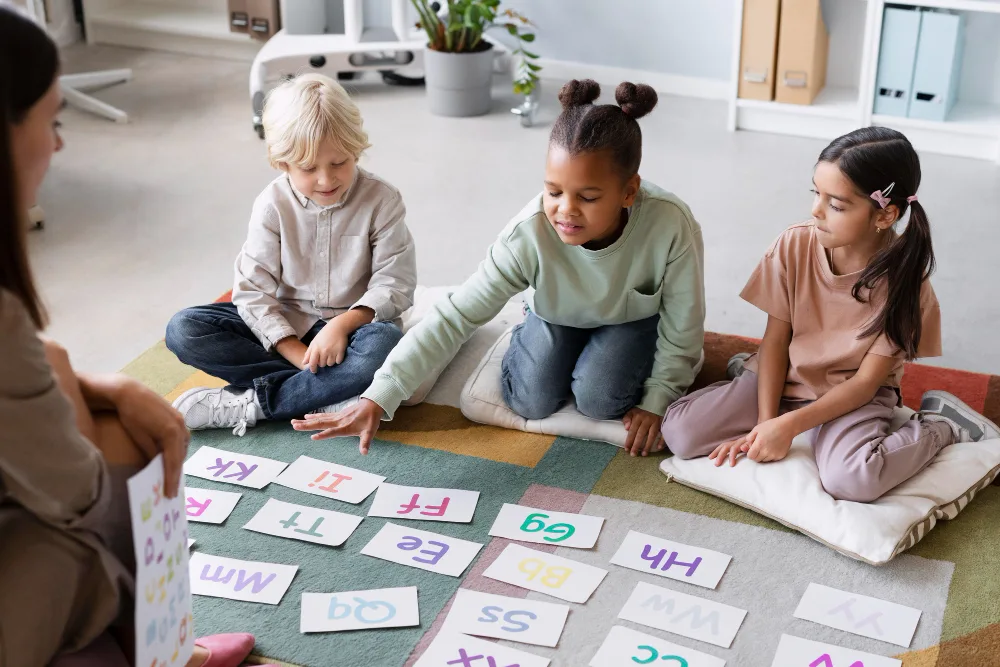
Would you be surprised to know that 1 in 6 children have a developmental disability? It’s a staggering number, but according to the CDC, it’s true: 17% (or 1 in 6) of children aged 3-17 in the United States have a diagnosed developmental disability.
This includes diagnoses like Autism, ADHD, Down Syndrome, Cerebral Palsy, and more. One thing that goes hand-in-hand with developmental disabilities that many people don’t know about is sensory processing challenges.
Sensory processing is a normal process in which the brain and nervous system receive information from all the senses and interpret it to create appropriate motor and behavioral responses.
Typical sensory processing lets us respond automatically and appropriately to the input we receive. For most of us, this happens seamlessly, and we don’t even think about it.
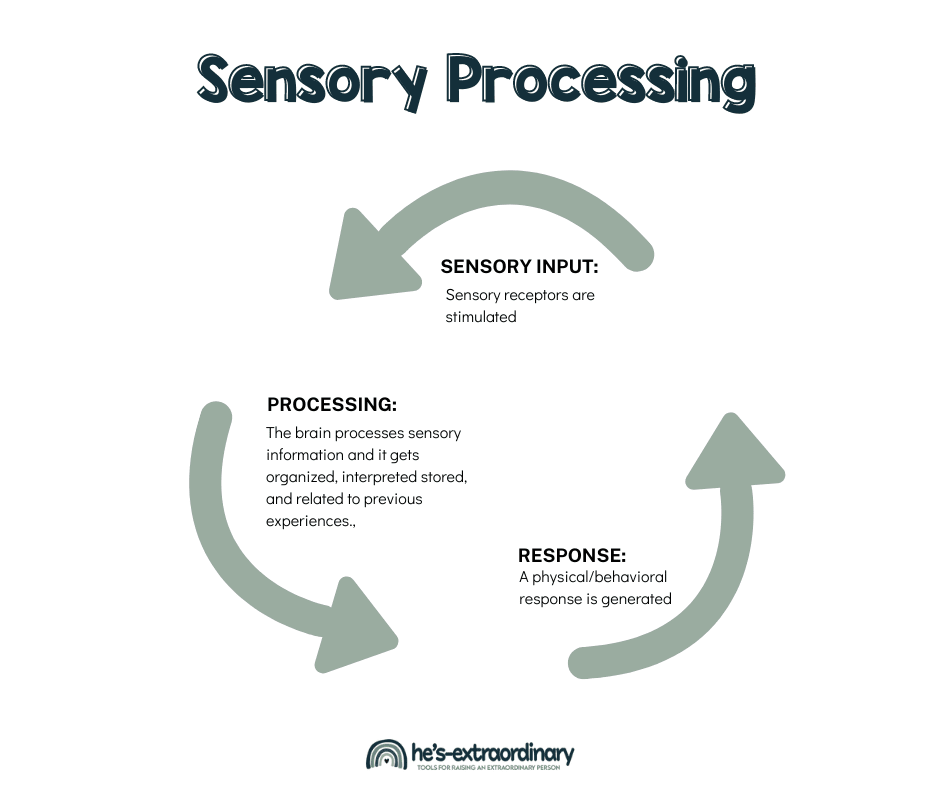 automatically and appropriately to the input we receive. For most of us, this happens seamlessly, and we don" width="940" height="788" />
automatically and appropriately to the input we receive. For most of us, this happens seamlessly, and we don" width="940" height="788" />
Sensory processing challenges (or Sensory Processing Disorder) occur when the brain has trouble receiving and responding to information from our senses. Sensory signals are not organized and processed into appropriate behavioral responses.
These challenges can present in many different ways, depending on how the individual is impacted. Some people may be overly sensitive to sounds, lights, or textures in their environment.
Others may be under-responsive to input. They might not notice when they bump into things, be unaware if they have a messy face, or seem hyperactive.
When sensory processing is well developed, it positively influences cognitive development, communication, self-regulation, motor skills, and interactions with the environment.
There are several types of sensory challenges, and children can experience various challenges simultaneously. So, they may avoid textures and sounds but seek movement and deep pressure.
The main types of sensory processing challenges are:
A wide range of behaviors may be related to sensory challenges because these challenges affect people in so many different ways.
Some of these behaviors are challenging to deal with, and you may believe they are intentional defiance or aggression, but they’re actually a form of sensory seeking or a result of overstimulation (sensory overload).
If you change the lens you use to view challenging behavior and try a new approach to addressing it; you can see a significant reduction in disruptive behavior.
In fact, this case study found that sensory interventions can reduce classroom disruptions by 30%, creating a better learning environment for all students.
So, what type of behaviors may be related to sensory processing challenges?
Hypersensitivity can lead to strong reactions, emotional dysregulation, sensory overload, and avoidance of stimuli.
If efforts to avoid distressing stimuli are unsuccessful, their behavior could escalate to a meltdown (screaming, hitting, destructive and unsafe behavior) or a shutdown (withdrawal, zoning out, unresponsive).
Hyposensitivity leads to sensory-seeking behavior in an attempt to meet sensory needs, which can become disruptive or dangerous. Children aren’t consciously aware of why they behave this way; it isn’t a conscious choice. It is a maladaptive way of meeting needs because alternatives have yet to be provided.
Hyposensitivity can also make children seem unaware of themselves, like they aren’t listening, unfocused, distracted, lazy, etc., as they don’t show an expected response to stimuli.
If sensory-seeking efforts are unsuccessful, or they’re forced to stay still, stop stimming, etc., their behavior could also escalate to a meltdown (screaming, hitting, destructive and unsafe behavior) or a shutdown (withdrawal, zoning out, unresponsive).
Sensory challenges impact so many children, and the behaviors that go hand-in-hand with sensory challenges impact the entire classroom. Even neurotypical children can become over- or under-stimulated.
Looking over this long list of behaviors, you can see why building a sensory-friendly classroom with tools and equipment available to support all sensory needs is so essential.
Research and case study findings show that sensory-friendly learning environments can:
A sensory-friendly classroom also provides a wide range of physical health benefits to children:
Finally, building a sensory-friendly classroom (and school) increases inclusivity and accessibility.
You can better address current and future education challenges and raise a generation of students who are better supported and more accepting, empathetic, compassionate, and understanding of others.
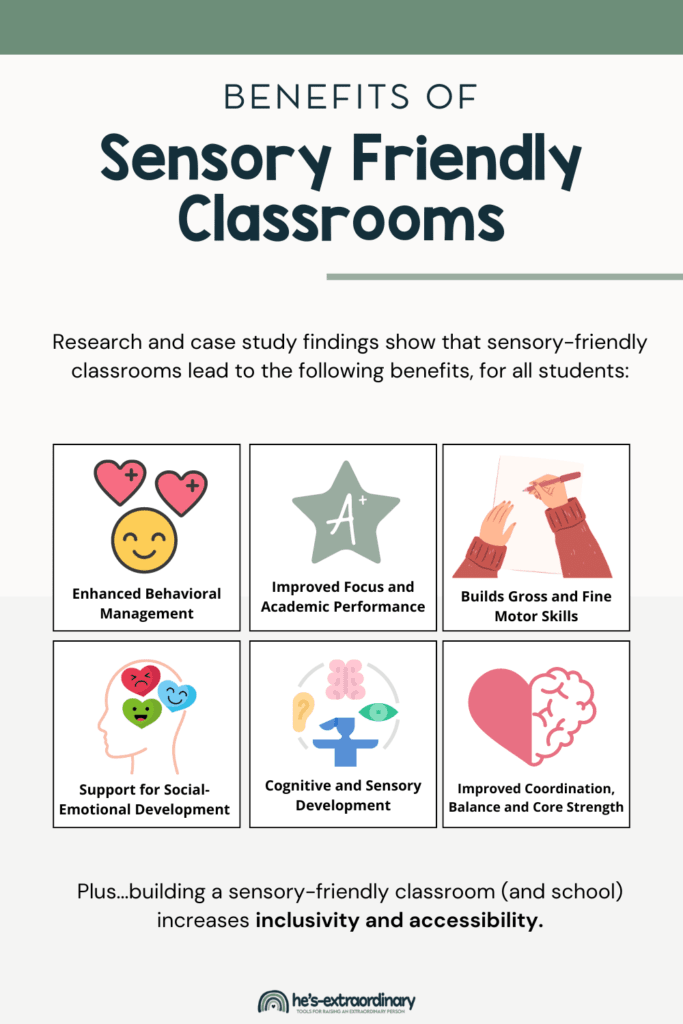
Creating a sensory-friendly classroom can help all students feel more comfortable and able to focus on learning.
Here are some strategies and adjustments to make a classroom sensory-friendly:
Use Natural Light: Maximize natural light by opening blinds or curtains. If artificial lighting is needed, choose soft, warm lights instead of harsh fluorescent lights. Lamps and string lights can provide soft lighting that doesn’t overstimulate.
Fluorescent Light Covers: If fluorescent lights are the only option, use covers to soften and diffuse the lights. This can help reduce eyestrain and discomfort; however, some students may notice noise and flickering still coming from the lights, even when covered.
Dimmer Switches: Install dimmer switches so you can adjust lighting levels based on students’ needs and activities.
Sound-Absorbing Materials: Carpets, rugs, curtains, and soft furnishings absorb sound and reduce echo. Consider acoustic panels on the walls and ceiling.
White Noise Machines: Use a white noise machine or soft background music to mask distracting noises. Noise-canceling headphones or earplugs can also help students with sound sensitivities.
Acoustic Dividers: Freestanding acoustic desk dividers can provide students with noise reduction and provide additional privacy. Larger portable panels can partition off areas in the classroom.
Visual supports help provide the structure and predictability children need, reducing anxiety and promoting independence.
They also help keep the classroom clean and organized. Visual clutter can be overstimulating, especially for hypersensitive children.
When choosing visual supports, use calming colors and simple, non-distracting visuals to create a more soothing atmosphere that reduces visual overstimulation. Avoid bright, overly stimulating colors.
Clear Signage: Use clear, simple signs and labels (with pictures) for different areas and materials in the classroom. Visual schedules can help students anticipate transitions and activities.
Visual Schedules: Visual schedules help provide stability and predictability, promote independence, and help children build healthy constructive habits. You can find various examples of visual schedules here.
Sensory zones are designated areas created to support different types of sensory needs. By creating zones, children can have a space to go if they are overstimulated or understimulated.
Create a dedicated space where students can retreat when they feel overwhelmed or overstimulated. This is a calming area for self-regulation.
Comfortable seating, soft lighting, and calming tools, such as prompts for deep breathing exercises, weighted items, or sensory tools, should be included.
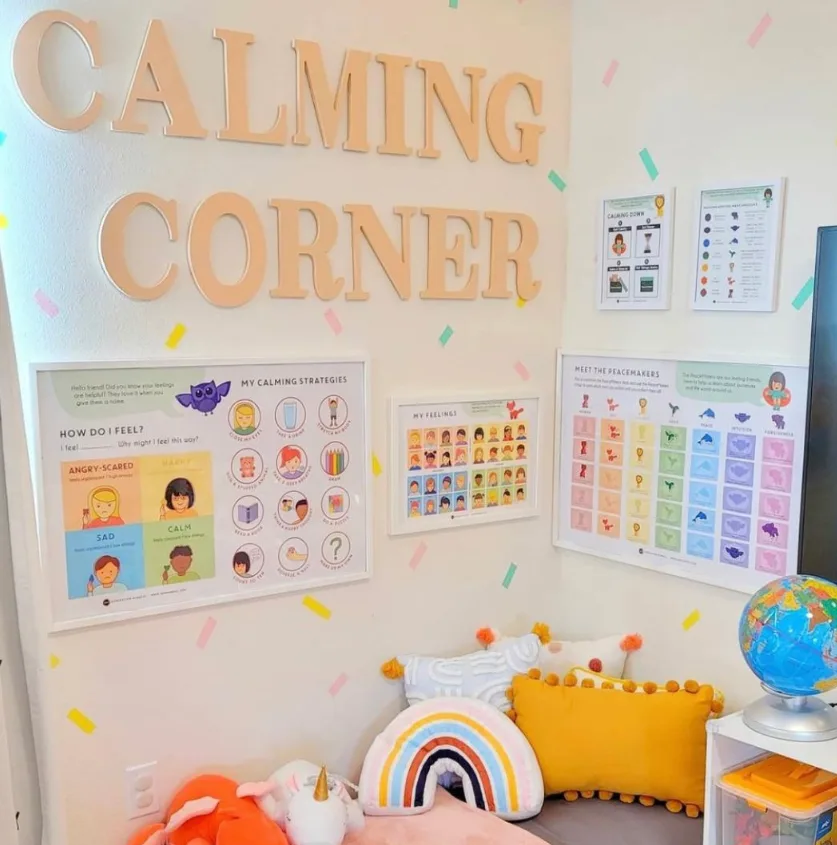
This is a designated space for children who are sensory-seeking.
Include sensory-motor equipment that allows children to safely meet their sensory-seeking needs in ways that are not disruptive to the rest of the classroom—for example, access to a small trampoline, a sensory swing, or a crash pad.
The experts at SensoryRX can provide personalized advice on the right equipment for your needs, space, and budget.
There may also be grants or funding available to cover equipment costs.
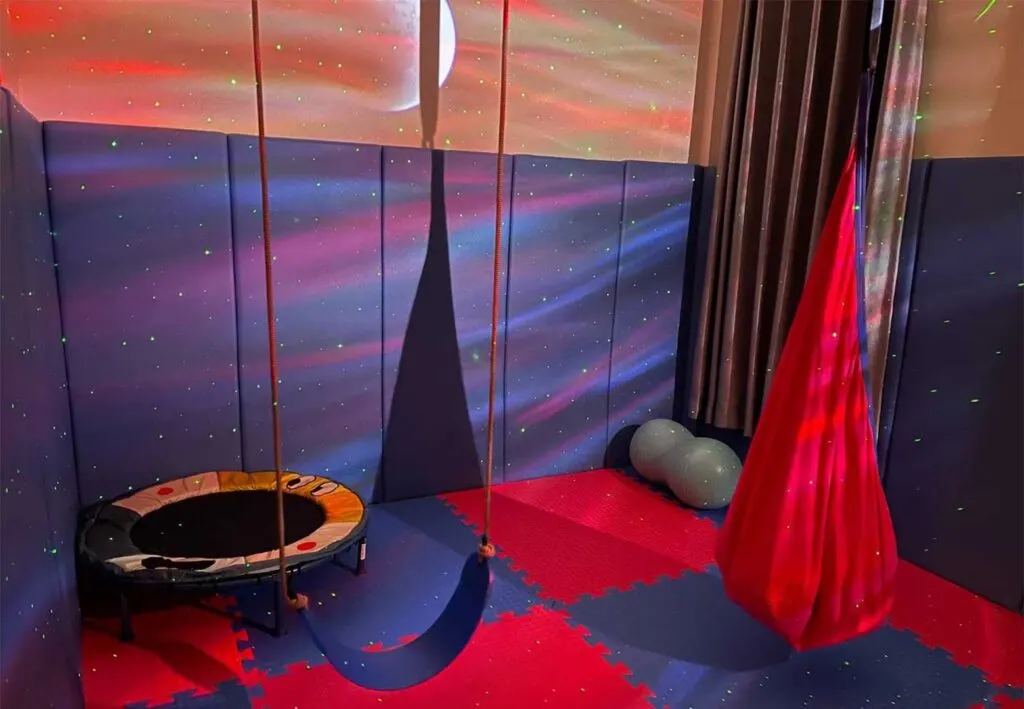
Provide different seating options to accommodate various sensory preferences, such as:
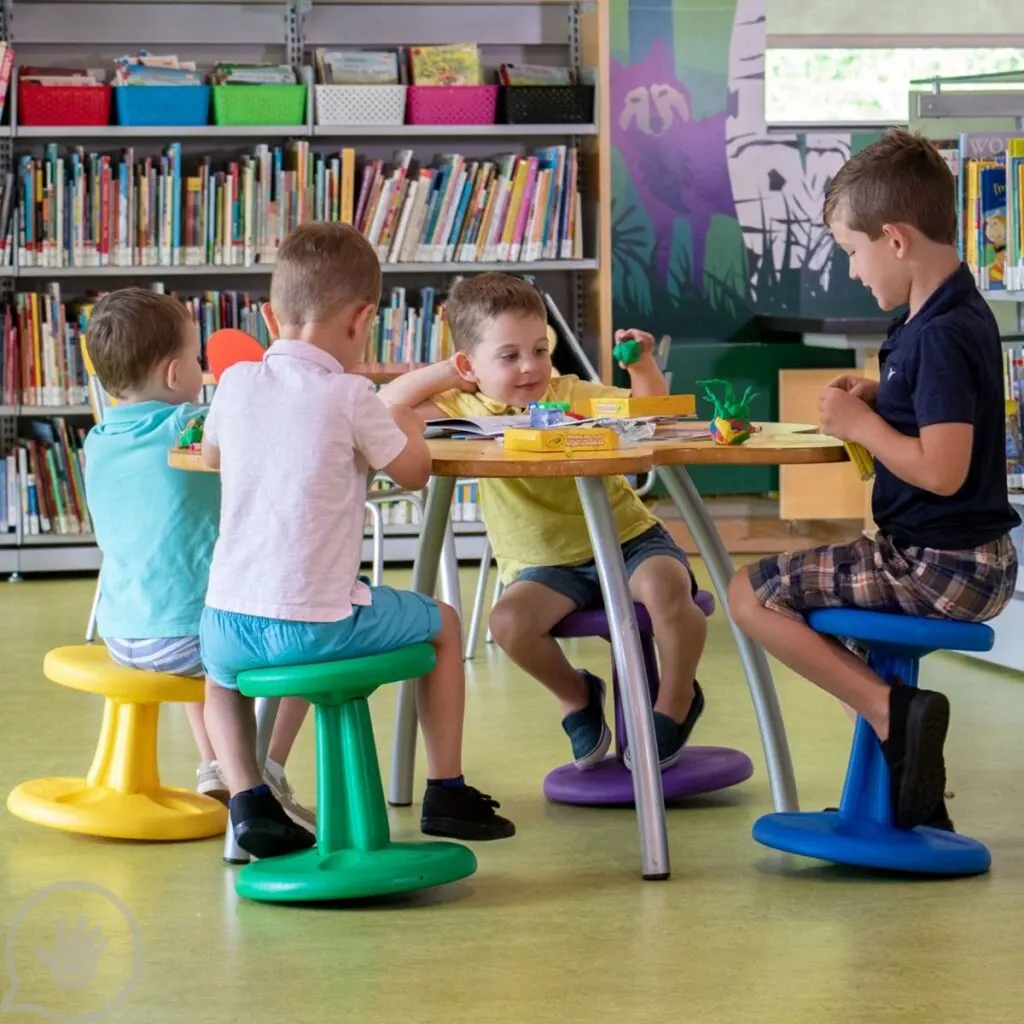
Maintain a consistent daily routine to provide students with both the security and predictability they need. Unlike adults, children’s brains are still developing, especially the prefrontal cortex, which is responsible for executive functions. This is where the ability to plan ahead and make predictions happens.
Children can’t do this accurately simply because their brains haven’t yet developed that skill. So, they depend on structure and routine.
Uncertainty is a major cause of anxiety, especially in children with developmental differences. A highly predictable routine helps children feel secure, know what to expect, and practice making simple predictions. This reduces incidents of disruptive behavior.
Minimizing anxiety and other potential triggers or stressors for children means they’re more likely to tolerate stimuli and more likely to be able to self-regulate in the classroom.
Self-regulation skills and meeting sensory needs go hand-in-hand. Children must learn to communicate, identify, and understand their emotions and how to sit with and experience uncomfortable emotions.
People use sensory-based coping skills to help manage their emotions. For example, a child might rock back and forth (a form of sensory regulation) to soothe themselves when feeling anxious (emotional regulation).
This skill begins developing in early childhood and continues developing throughout life into more complex social-emotional skills. These skills often require explicit teaching for neurodivergent students. Social-emotional learning programs, like The Zones of Regulation, can help develop these crucial skills.
It’s so important to work on developing skills in both areas because when individuals experience sensory overload or under-stimulation, it leads to emotional dysregulation, anxiety, frustration, or meltdowns.
Both sensory and emotional regulation involve the autonomic nervous system. Overstimulation of the sensory system can activate the body’s stress response, sometimes known as fight-or-flight, making it harder to regulate emotions.
Understanding how emotional and sensory regulation are connected can help you create environments and strategies that support both aspects, leading to better overall well-being and functioning for kids with sensory processing challenges.
The Understanding and Coping with Feelings Mega Bundle offers a wide range of educational tools to help you help children develop these crucial skills.

Creating a sensory-friendly classroom not only improves academic performance and reduces disruptions. It also improves social-emotional development, makes learning environments more inclusive and accepting, and helps all students feel more comfortable and ready to learn.
Teachers can create a sensory-friendly classroom by making just a few changes: adjusting the physical environment, creating sensory zones, providing predictability, creating a positive atmosphere, and teaching emotional regulation skills.